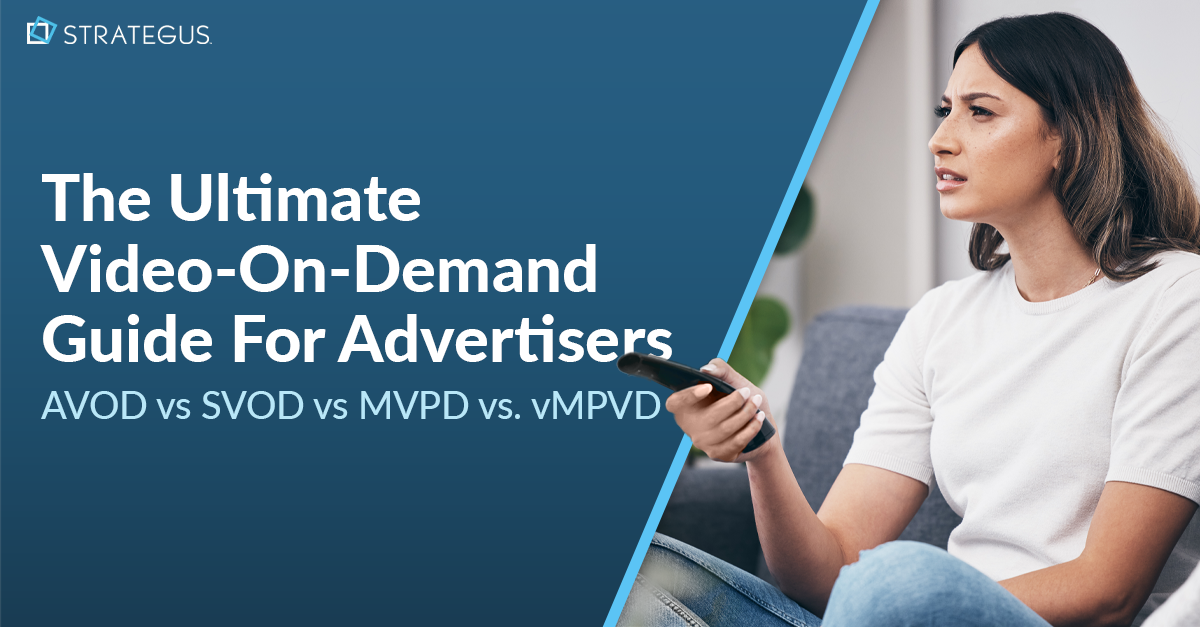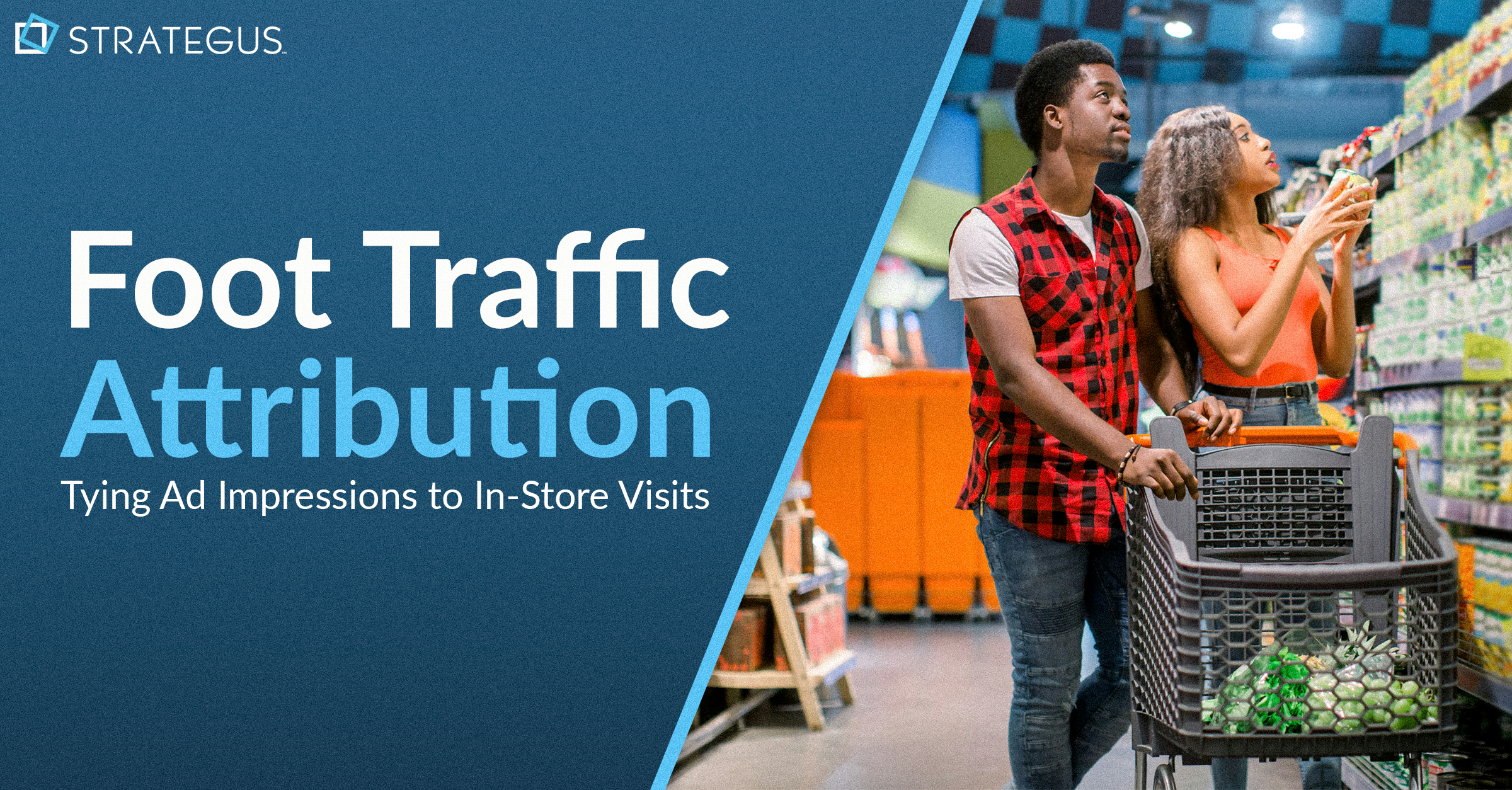- Home
- Strategus Blog
- AVOD vs SVOD vs MVPD vs. vMPVD: Ultimate VOD Guide For Advertisers
AVOD vs SVOD vs MVPD vs. vMPVD: Ultimate VOD Guide For Advertisers
 Andy Dixon
Andy Dixon
14 minutes read

We really can’t say we’re in the dawn of a new era in marketing without acknowledging the barrage of new trends and terms popping up seemingly every day. There are numerous acronyms to keep up with in the realm of digital advertising.
First and foremost, let’s clarify one thing: SVOD, AVOD, MVPD, vMVPD… It’s all OTT!
OTT (Over-The-Top) describes how video is delivered and accessible directly through the internet, bypassing traditional cable or satellite broadcasts. It’s an umbrella term that encompasses all the different platforms, methods, and devices through which digital content is accessed online.
With this in mind, let's dive into the details of MVPD, vMVPD, AVOD, and SVOD, understanding how each plays a unique role in the OTT ecosystem.
What’s the Difference Between MVPD, vMPVD, AVOD, and SVOD?

The world of digital advertising is filled with acronyms that can be overwhelming. To make sense of it all, it's essential to see how MVPD, vMVPD, AVOD, and SVOD fit within the broader OTT landscape.
Each platform has distinct characteristics and business models that define their place in the digital media world. This guide will break down these differences, helping you navigate the complex OTT ecosystem effectively. Take a deep breath and let's get started!
MVPD: The Traditional Contender

MVPDs (Multichannel Video Programming Distributors) like Comcast and DirecTV provide a wide range of TV channels via cable or satellite, supported primarily by subscriber fees and sometimes ads. They appeal to viewers who prefer a traditional TV experience, offering everything from live sports to news and entertainment.
Examples of MVPD Platforms: AT&T U-Verse, Comcast Xfinity, Cox, DirecTV, Dish Network, Verizon Fios
Current Trends and Digital Integration: To combat the cord-cutting trend, MVPDs are integrating streaming services such as Netflix into their offerings, creating hybrid models that blend traditional and digital content delivery. For example, Comcast's Xfinity X1 platform merges traditional channels with streaming apps like Netflix and Amazon Prime Video, accessible through one interface. MVPDs are also enhancing their broadband infrastructure to support high-quality streaming and forming partnerships with streaming services to offer bundled packages, such as Verizon's partnership with Disney+.
vMVPD: The Virtual Evolution

vMVPDs (Virtual Multichannel Video Programming Distributors) are a digital evolution of traditional MVPDs, offering live and on-demand TV channels over the internet without the need for physical cable infrastructure. Services like YouTube TV, Sling TV, and Hulu + Live TV fall into this category.
Examples of vMVPD Platforms: DirecTV Stream, fuboTV, Hulu, Philo, Sling TV, YouTube TV
Advantages and Appeal: vMVPDs attract cord-cutters who seek the live TV experience but prefer the flexibility and cost savings of streaming. They offer channel bundles similar to traditional cable but are accessible via internet-connected devices, providing the convenience of streaming with the familiarity of live TV.
Challenges and Market Position: While vMVPDs offer flexibility and competitive pricing, they face challenges such as fluctuating content licensing costs and competition from both traditional MVPDs and purely on-demand streaming services. However, their ability to adapt quickly to market trends and consumer preferences keeps them relevant in the rapidly evolving digital landscape.
AVOD: The Free Streaming Champion

AVOD (Advertising-Based Video On Demand) platforms like YouTube and Hulu’s free tiers offer free content supported by advertisements. This model attracts cost-conscious viewers who don’t mind ad interruptions in exchange for free access.
Examples of AVOD Platforms: Crackle, Hulu (ad-supported tier) Plex, Pluto TV, Samsung TV Plus, Tubi, Vudu
Growth and Market Dynamics: The growth of AVOD is driven by consumer demand for free, accessible content, especially during economic downturns. Platforms like Pluto TV and Tubi excel in integrating ads without disrupting the viewer experience, using data analytics to tailor ads to viewer preferences.
Strategic Use of Ads: AVOD platforms must balance ad frequency with viewer satisfaction to avoid driving users away. They utilize user data to tailor ads, making commercials less intrusive and more relevant, which improves viewer satisfaction and ad effectiveness.
SVOD: The Premium Experience

SVOD (Subscription Video On Demand) services like Netflix, Amazon Prime Video, and Disney+ charge a subscription fee for ad-free access to extensive content libraries. These platforms cater to users who value a premium viewing experience without ads.
What’s important to emphasize about SVOD services is that they are typically premium, ad-free subscriptions. Ah, now you’re probably thinking: Wait a minute! What about platforms like Hulu, where there are both ad-supported and ad-free versions of the service? SVOD for our purposes refers to the ad-free version. This applies to any streaming service that offers multiple pricing tiers.
Examples of SVOD Platforms: Amazon Prime Video, Apple TV, Disney+, HBO Max, Hulu (ad-free tier), Netflix, Paramount+
Content Strategy and Viewer Retention: SVOD platforms invest heavily in original content to attract and retain subscribers. For example, Netflix has significantly increased its budget for original programming, ensuring it offers compelling and innovative storytelling. Exclusive content not only differentiates SVOD services from competitors but also fosters viewer loyalty.
Impact of Content Exclusivity and Competitive Dynamics: Content exclusivity is essential for viewer loyalty, with platforms securing rights to popular shows and movies or producing original content. The pursuit of exclusive content intensifies competition among SVOD platforms, encouraging continuous innovation and expansion of content libraries. This benefits viewers with more high-quality content choices and pushes the industry towards higher production values and better user experiences.
Each of these platforms—MVPD, vMVPD, AVOD, and SVOD—plays a distinct and vital role in the digital media landscape, catering to specific viewer preferences and economic models. MVPDs and vMVPDs offer a blend of traditional and modern viewing experiences, appealing to those who value live and on-demand content delivered seamlessly. AVOD platforms attract cost-conscious viewers with free, ad-supported content, while SVOD services provide a premium, ad-free experience for those willing to pay for high-quality, exclusive programming.
Understanding these distinctions allows advertisers and content providers to tailor their strategies more effectively, ensuring they can engage diverse audiences across various video distribution platforms. By leveraging the unique strengths of each platform, they can maximize reach and impact in a rapidly evolving media environment.
Strategic Marketing Approaches in AVOD and SVOD
As consumers increasingly favor on-demand content over traditional media, advertisers and content providers face the dual challenge of capturing and maintaining viewer attention.
From the intricacies of Advertising-based Video On Demand (AVOD) to the curated experiences of Subscription Video On Demand (SVOD), understanding the unique dynamics of each platform is key to crafting compelling marketing strategies. Here’s how these platforms are revolutionizing engagement and transforming viewer expectations.
Marketing Strategies in AVOD
Engagement Tactics: AVOD platforms enhance engagement through highly targeted advertising and interactive formats. Advertisers can use dynamic ad insertion to place ads at optimal moments based on viewer behavior and demographics, ensuring maximum relevance and impact. Interactive ads, such as clickable overlays or integrated polls, transform passive watching into an interactive experience, significantly boosting engagement rates.

Success Metrics and Optimization: The effectiveness of AVOD marketing is measured using advanced analytics that track viewer engagement rates, ad recall, and conversion metrics. Advertisers can employ A/B testing and sophisticated data analytics to refine ad targeting and formatting, ensuring each campaign aligns closely with viewer preferences. This precise approach helps optimize ad spend and improves overall campaign effectiveness.
Marketing Strategies in SVOD
Building Subscriber Loyalty: For advertisers looking to engage with SVOD audiences, understanding the importance of personalized content recommendations and exclusive member benefits is crucial. SVOD platforms use advanced algorithms to analyze viewer habits and tailor content suggestions, creating a more personalized viewing experience. Advertisers can leverage this personalization by aligning their brands with exclusive early access content, special member-only events, and other perks that enhance perceived value.
Importance of Original Content: Investment in original content is a key strategy for SVOD platforms, and it presents unique advertising opportunities. Exclusive series and films, like Amazon Prime Video’s "The Marvelous Mrs. Maisel" and "Jack Ryan," attract and retain subscribers by offering content that cannot be found elsewhere. Advertisers can capitalize on this exclusivity by sponsoring original content or integrating their brands into the storytelling, thus boosting engagement and elevating their prestige among a dedicated subscriber base.

In both AVOD and SVOD, strategic marketing is crucial. AVOD strategies are designed to maximize ad impact and viewer engagement, while SVOD strategies focus on building subscriber loyalty through exclusive, high-quality content. Understanding and leveraging these strategies are essential for thriving in the competitive digital streaming environment.
Marketing Strategies in SVOD
For advertisers, strategic marketing on AVOD and SVOD platforms is crucial. AVOD strategies should focus on maximizing ad impact and viewer engagement through targeted and interactive ads. In contrast, SVOD strategies should aim to build subscriber loyalty through exclusive, high-quality content and personalized experiences.
By understanding and leveraging the distinct advantages of AVOD and SVOD, advertisers can create highly effective campaigns that thrive in the competitive digital streaming environment. At Strategus, we specialize in tailoring advertising strategies to meet the specific goals of our clients, ensuring that their campaigns reach the right audience on the right platform. Let us help you harness the power of these dynamic platforms to achieve your advertising objectives and drive success in the ever-evolving digital market.
AVOD vs. SVOD – Which Reigns Supreme in OTT?
As we explore the competitive dynamics of the streaming industry, AVOD (Advertising-based Video On Demand) and SVOD (Subscription Video On Demand) present contrasting approaches to capturing viewer interest. Each model leverages different strategies for revenue generation and audience engagement, reflecting their distinct value propositions.
Here's a comparative look at these models through a table format to highlight their differences:
| Feature | AVOD | SVOD |
|---|---|---|
| Revenue Generation | Primarily through advertisements. | Mainly from monthly or annual subscription fees. |
| Primary Audience | Cost-conscious viewers who prefer free or low-cost access. | Viewers who value an ad-free experience and are willing to pay for quality content. |
| Appeal During Economic Downturns | More appealing as consumers look to cut costs. | Less appealing due to subscription costs, potential for subscription fatigue. |
| Content Access | Often offers a mix of free and premium tiers with ads. | Typically offers all content ad-free with tiered viewing options based on price. |
| Viewer Experience | Ad interruptions are common but improving with targeted and interactive ads. | Seamless and uninterrupted viewing, with a focus on user-friendly interfaces. |
Prospective Market Trends
The OTT landscape is set for dynamic changes, influenced by several key factors:
-
Technological Advancements: The spread of high-speed internet globally is expected to boost both AVOD and SVOD services. Innovations like improved personalized content recommendations and enhanced streaming quality (including 4K and VR) are poised to elevate user experiences, potentially increasing the willingness to pay for premium services.
-
Economic and Privacy Concerns: Growing concerns over data privacy and ad saturation could shift some consumer preferences toward SVOD models, which typically collect less personal data for advertising purposes than AVOD services. Moreover, economic downturns and the rising number of SVOD platforms might lead to 'subscription fatigue,' where viewers might switch to more affordable AVOD options or rotate subscriptions based on content availability.
-
Hybrid Models: An emerging trend is the integration of AVOD and SVOD within single platforms, offering viewers both free, ad-supported access and premium, ad-free options. This model provides flexibility and caters to a wider audience by combining the appeal of free content with the option to upgrade for a premium, ad-free experience.
While predicting which model will dominate is challenging, it's clear that both AVOD and SVOD will continue to adapt and evolve. The future might not see a definitive winner but rather a more integrated approach to content delivery that aligns with varied viewer preferences and economic realities.
The Shift from MVPD to AVOD and SVOD
The media landscape is witnessing a significant transformation as Multichannel Video Programming Distributors (MVPDs) evolve to meet the growing demand for streaming and on-demand content. This shift reflects a broader industry trend towards digital platforms that offer greater flexibility and choice for consumers.
Evolution and Adaptation of MVPD
MVPDs are not merely spectators in the shift towards digital; they are active participants, reshaping their strategies to thrive in the new era. Key adaptations include:

 Investments in Proprietary Streaming Technologies: To compete directly with pure-play streamers, several MVPDs have launched their own streaming services. For instance, AT&T restructured their DirecTV offerings under AT&T TV, which blends traditional TV with internet-based streaming, providing a bridge for customers transitioning from cable to purely digital consumption.
Investments in Proprietary Streaming Technologies: To compete directly with pure-play streamers, several MVPDs have launched their own streaming services. For instance, AT&T restructured their DirecTV offerings under AT&T TV, which blends traditional TV with internet-based streaming, providing a bridge for customers transitioning from cable to purely digital consumption.
 Enhanced User Experience: Improvements in user interfaces and the integration of advanced features such as voice search, personalized recommendations, and mobile access reflect MVPDs' commitment to modernizing their service offerings to match the convenience and flexibility of SVOD and AVOD services.
Enhanced User Experience: Improvements in user interfaces and the integration of advanced features such as voice search, personalized recommendations, and mobile access reflect MVPDs' commitment to modernizing their service offerings to match the convenience and flexibility of SVOD and AVOD services.
Challenges Ahead:
Despite these efforts, MVPDs face several strategic challenges:
 Maintaining Subscriber Bases: As consumers increasingly cut the cord in favor of cheaper, more flexible streaming options, MVPDs must find compelling ways to retain subscribers. This often involves not only enhancing content offerings but also restructuring pricing models to offer more customization and flexibility.
Maintaining Subscriber Bases: As consumers increasingly cut the cord in favor of cheaper, more flexible streaming options, MVPDs must find compelling ways to retain subscribers. This often involves not only enhancing content offerings but also restructuring pricing models to offer more customization and flexibility.
 Innovating Offerings: Innovation is crucial as the competition from AVOD and SVOD platforms intensifies. MVPDs must continually evolve their content delivery and service options to meet the changing preferences of a consumer base that values on-demand access and a wide array of content choices.
Innovating Offerings: Innovation is crucial as the competition from AVOD and SVOD platforms intensifies. MVPDs must continually evolve their content delivery and service options to meet the changing preferences of a consumer base that values on-demand access and a wide array of content choices.
 Navigating Content Costs and Distribution Rights: Acquiring and retaining the rights to popular content is increasingly complex and expensive. MVPDs must navigate these waters carefully to ensure they can offer the high-value content necessary to attract and retain subscribers without unsustainable increases in costs.
Navigating Content Costs and Distribution Rights: Acquiring and retaining the rights to popular content is increasingly complex and expensive. MVPDs must navigate these waters carefully to ensure they can offer the high-value content necessary to attract and retain subscribers without unsustainable increases in costs.
As the shift from traditional MVPD services to AVOD and SVOD continues, MVPDs must leverage their existing infrastructure and customer base while aggressively pursuing digital transformation strategies. This evolution is critical not only for staying relevant but also for capitalizing on new opportunities in a rapidly changing media environment.
Harnessing the Future of On-Demand Video
In our exploration of MVPD, vMVPD, AVOD, and SVOD platforms, we've highlighted how each caters to distinct viewer preferences and necessitates tailored advertising strategies. MVPDs and vMVPDs are integrating digital technologies to stay competitive, AVOD platforms attract wide audiences with free content, and SVOD services offer premium, ad-free experiences.
At Strategus, we specialize in navigating the complex landscape of connected TV and video on demand. Our expertise allows us to tailor your advertising strategy to meet your specific goals, ensuring your campaigns reach the right audience on the right platform. Let us help you harness the power of these dynamic platforms to achieve your advertising objectives and drive success in the ever-evolving digital market. Contact us today to speak to a CTV expert!

Andy Dixon is a seasoned Content Writing Specialist at Strategus, renowned for his expertise in creating engaging and impactful digital content. With over a decade of experience in content creation, Andy has honed his skills in a variety of niches, ranging from technology and marketing to education.
Strategus is a managed services connected TV(CTV) advertising agency with over 60,000+ campaigns delivered. Find out how our experts can extend your team and drive the result that matter most.
Talk to an Expert
Table of Contents
- What’s the Difference Between MVPD, vMPVD, AVOD, and SVOD?
- MVPD: The Traditional Contdner
- vMPVD: The Virtual Evolution
- AVOD: The Premium Experience
- SVOD: The Premium Experience
- Strategic Marketing Approaches in AVOD and SVOD
- AVOD vs. SVOD - Which Reigns Supreme in OTT?
- The Shift from MVPD to AVOD and SVOD
- Harnessing the Future of On-Demand Video
Seeking a Custom CTV Strategy That Delivers?
What to read next

Third-Party Data Targeting for CTV: Benefits & Tactics
Third-party data. It’s a term that’s thrown around, and yet few take the time to detail its pros and cons — much less strategies for using...
7 minutes read

First-Party Data Targeting: Benefits and Tactics for CTV Advertising
First-party data is the information that companies collect directly from their customers rather than through intermediaries. Advertisers use this...
10 minutes read

Foot-Traffic Attribution: Tying Ad Impressions to In-Store Visits
The marketing funnel has changed. Today’s shoppers often begin researching products from the comfort of their homes and don’t set foot into a store...
8 minutes read

CTV Attribution: What It Is and How It Works
Connected TV (CTV) viewing is on the rise — and that’s good news for marketers. Not only can CTV ads be precisely targeted to individual households,...
9 minutes read
















